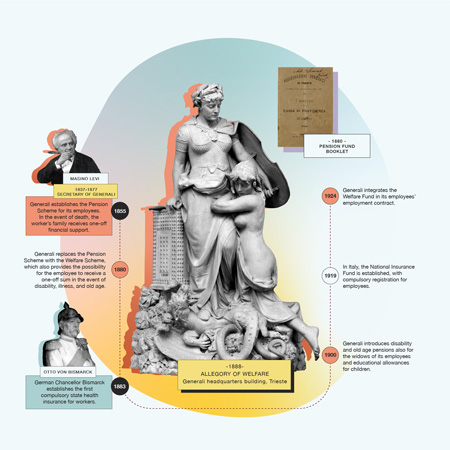The warrior woman, an allegory of welfare
Preface
The sculpture group is located inside Palazzo Geiringer, Assicurazioni Generali’s head office in Trieste, initially at the top of the grand staircase, and today in the assembly hall. It is stunningly beautiful: a warrior, with a proud expression and sinuous body protected by a suit of armour that traces her contours. Sensual in her steadfastness and confidence, sculptural, and powerful, she is standing, a cloak over her shoulders and protected by a shield tucked over her left arm.
But the shield is not only protecting her, it also shelters another, smaller, female figure: young, nude, afraid. She seems to cling to the warrior’s side, and although she is covering her eyes with one hand, almost unwilling to see, yet she still looks at the monster at her feet, ready to devour her. It is a dragon, slithering and terrifying with its marble scales.

Ivan Rendić, Allegory of Welfare (1886-1888)
Assicurazioni Generali Historical Archive
ph. Massimo Gardone
Its wings are crushed to the ground by the warrior’s weight, its tail twisted like the body of a snake, and its mouth open wide, showing its fangs and long tongue, as if in a frightened and frightening scream.
The warrior holds it to the ground with her right foot alone, pressing on the monster’s body, with ineffable and indisputable grace.
Completing the composition is a studded safe on which the warrior rests her right hand, a sword clearly visible to protect it.
I would like to begin my thesis on the role of women as the main subject of the artistic interpretation of human feelings with the tale of this splendid sculpture group by Ivan Rendić, an artist from Split.
Because while, in the history of art and literature, women have always been inspiring muses and, more importantly, the protagonist and ultimate synthesis of every powerful human feeling, in the case of the statue described above, the woman represents welfare. She stands firm in her defence of the weak.
“Mr Secretary General states that the sculptor Rendić is the artist of the sketch of a group for the staircase of the new office.”
At the end of a dry and decisive meeting inside the Generali headquarters in Trieste, it was decided that the sculpture would be entrusted to Ivan Rendić, and the main figures would be female: the warrior, a woman, and the vulnerable girl threatened by the dragon.
This is the story of a woman who protects and supports, who is ready to launch an attack but can also stand guard with one hand on the weak and the other on the safe, protecting human and material capital.
And Generali, which commissioned this work, would be a forerunner in terms of retirement planning and what we now know as corporate welfare.
It was the first company in Italy to implement measures for the future of its employees: the first form of retirement provision for its employees was studied and developed in the years 1853 and 1854 thanks to the foresight of secretary general Masino Levi and took the form of a Pension Scheme.
The establishment of the Pension Scheme represented a significant advantage in terms of employees’ wellbeing. Generali employees could count on guarantees for their own health and old age, as well as that of their families, and their workplace was also a distinguishing factor in society; it is said that Generali employees were so greatly trusted by the community that they could easily obtain credit from local traders, who had faith in the solidity of the company they worked for. Support for employees also resulted in mutual benefit for workers and company alike, since it strengthened their attachment to the company with excellent results for the development of social issues.
This is why I am beginning my degree thesis with the story of this specific sculpture group: because if art is often a woman, so too is this new “secular goddess”: welfare.
HISTORY
.jpg/lang:en/210416_responsabilita-sociale-eng_2-(2).jpg)
The first proposal to create a form of support for employees aimed to set up a fund to guarantee pensions for disabled employees, and for widows and orphans of employees who died after ten years of continuous service. After long and thoughtful deliberations, the project was approved by the shareholders’ meeting, and a benefits fund for families in the event of an employee’s death was activated, starting from the 1st of January 1855. Individual employees could join the scheme on a voluntary basis.
The so-called Pension Scheme - later Welfare Scheme, and finally Welfare Fund - involved the workers and their families at the same time, offering them valuable support in times of difficulty such as death, disability, illness, and finally old age. At the same time, this intervention increased the employee’s sense of belonging and their bond of loyalty with the company.
